Łomża
| Łomża | |||
|---|---|---|---|
|
Panorama of Łomża City | |||
| |||
 Łomża | |||
| Coordinates: 53°10′N 22°5′E / 53.167°N 22.083°E | |||
| Country |
| ||
| Voivodeship | Podlaskie | ||
| County | city county | ||
| Established | 9th century | ||
| Town rights | 1416 | ||
| Government | |||
| • Mayor | Kacper Sikorski | ||
| Area | |||
| • Total | 32.67 km2 (12.61 sq mi) | ||
| Elevation | 95 m (312 ft) | ||
| Population (December 31, 2014) | |||
| • Total | 62 779[1] | ||
| Time zone | CET (UTC+1) | ||
| • Summer (DST) | CEST (UTC+2) | ||
| Postal code | 18-400 to 18-404 | ||
| Area code(s) | +48 86 | ||
| Car plates | BL | ||
| Website | http://www.lomza.pl/ | ||
Łomża (/ˈwɒmʒə/; Polish pronunciation: [ˈwɔmʐa]) is a city in north-eastern Poland, approximately 150 kilometres (90 miles) from Warsaw and 80 kilometres (50 mi) from Białystok. It is situated alongside the Narew river as part of the Podlaskie Voivodeship since 1999. Previously, it was the capital of the Łomża Voivodeship from 1975 to 1998. It is the capital of Łomża County and has been the seat of the Roman Catholic Diocese of Łomża since 1925.
Łomża is one of the principal economic, educational, and cultural centres of north-eastern Masovia as well as one of the three main cities of Podlaskie Voivodeship (beside Białystok and Suwałki). It lends its name to the protected area of Łomża Landscape Park. The town is also the location of the Łomża Brewery.
History
Łomża was founded in the 10th century, on the site of the present day village called Stara Łomża (Old Łomża). It was first mentioned in official records in the 14th century. Łomża received its municipal rights in 1416, and became an important political and economic center in the mid-16th century.[2][3]
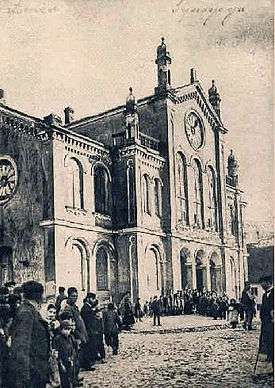
Polish prince Bolesław IV the Curly (Polish: Bolesław Kędzierzawy) built a palace there in the 12th century. In 1444 the town was granted an exemption from the transit tax on Narew river contributing to its further development. In the 16th century Zygmunt II August gave Łomża the right to hold great fairs three times a year, similar to Warsaw and Płock. In 1618 a great fire destroyed most of the city, and six years later, an epidemic killed 5,021 persons decimating its population. A series of disasters (including the Swedish invasion and the Cossack raids) resulted in its rapid decline.[2][3]
References to Jewish residents in Łomża date to 1494. The population numbers date back only to 1808, when 157 Jews were officially counted. A magnificent stone synagogue was built there in 1881 on the initiative of Rabbi Eliezer-Simcha Rabinowicz. The Great Synagogue designed by Enrico Marconi became a centre of the Zionist movement.[2] In 1931, there were 8,912 Jews who lived in the city.

During the Polish-Soviet War of 1919-1921, Łomża was directly in the path of the Russian army's catastrophic retreat following its defeat at the Battle of Warsaw. On August 15, 1920, the Soviet General August Kork of the 15th Army mounted an unsuccessful defence of the town against the Polish Fourth Army of General Leonard Skierski, before continuing its retreat eastward under pressure from the Polish forces.[4]
In September 1939, during the joint Soviet and German invasion of Poland, Łomża was largely destroyed by the Nazis during the Battle of Łomża, then held and turned over to the Red Army.[5] It remained in the Soviet hands until Operation Barbarossa. In June 1941, at the onset of the Russian campaign it was taken over by the German forces. On 12 August 1941, a Łomża Ghetto was created in the vicinity of the Old Market Square (Stary Rynek). The Nazi Einsatzkommando under SS-Obersturmführer Hermann Schaper committed mass killings of alleged Soviet collaborators a few days later. The number of Jews herded into the Ghetto from surrounding villages and towns including Jedwabne, Stawiski, Piątnica, Rotki, Wizna, Łomża and others, ranged from 10,000 to 18,000. Over two thousand people were murdered in the Giełczyn Forest outside of town. Many Jews perished from malnutrition and diseases such as dysentery and typhus. The rest were shipped to Auschwitz. The ghetto was liquidated in the final deportation action on 1 November 1942.[2][3][6][7] Only a small number of the Jews of Łomża survived the Holocaust; some found refuge with Catholic Polish families.[2] At the end of 1944, the USSR recaptured the territory. Following the Yalta Conference the Soviets ceded the city back to Poland, with population reduced to 12,500 inhabitants.
In the years 1946-1975 the oldest part of the city was rebuilt. New housing estates came into existence along with several industrial plants, among them Łomża cotton and furniture factories and starch manufacturing PEPEES, as well as municipal thermal power station. The city transit system was also established during this time. By the beginning of the 1970s, the population had reached almost 30,000 inhabitants.[8]
Demographics
| Description | Total | Women | % | Men | % |
|---|---|---|---|---|---|
| Population of Łomża | 63,036 | 32,652 | 51.8 | 30,384 | 48.2 |
| Population density (people/km²) | 1,929.5 | 999.4/km² | 930.0/km² | ||
Łomża is the third largest city in Podlaskie Voivodeship with 63,036 inhabitants. At the end of 2006, the population growth was positive and amounted to 1.3% per 1000 inhabitants whereas the balance of migration was negative (-520).[9] The unemployment rate in May 2008 amounted to 10,2%.[10] According to data from 2006,[9] an average income per inhabitant amounted to 2,942.31 zł.[9]
Historical population of Łomża between 1808 and 1931
General population in blue. Number of Poles of Jewish faith in green. Source: Qiryat Tiv'on, Israel.[2]

Religion
The inhabitants of Łomża are predominantly Roman Catholic, although over the centuries in addition to the Catholics, followers of other religions have settled there. There is evidence of many Jewish and Protestant gravestones at the Łomża cemeteries, particularly the two abandoned Jewish cemeteries.
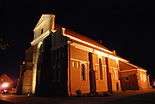 Cathedral of Saint Michael the Archangel by night
Cathedral of Saint Michael the Archangel by night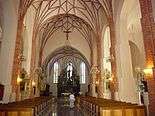 Main Nave of the Cathedral
Main Nave of the Cathedral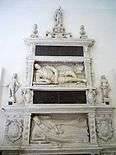 Inside the Cathedral, tombstone from 1589
Inside the Cathedral, tombstone from 1589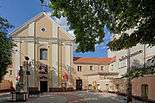 Capuchin parish church (18th century) in Łomża
Capuchin parish church (18th century) in Łomża
Education
The history of education in Łomża dates back to the early 15th century, when the first parish was founded. In 1614, Jesuits residing in Łomża created a Collegium. One of its rectors was Andrew Bobola. The educational level has not decreased after the KEN school pijarom in 1774. Łomża has educated a number of dignitaries, among others: Szymon Konarski, Rafał Krajewski, Jakub Ignacy Weight, Wojciech Szweykowski, and Adam Chętnik.
Currently in Łomża there is a well-developed network of public and private schools at all levels. There are seven primary schools, eight schools, ten secondary schools, six universities (including three non-public) and two schools of art. The educational level in Łomża is high, based on the results of the exams and countrywide lists. For example, I Liceum Ogólnokształcące rates as a top national and central Poland school.
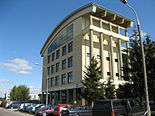 College of Computer Science and Business Administration in Łomża.
College of Computer Science and Business Administration in Łomża.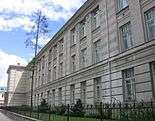 A building of the 1st grammar school, named after Tadeusz Kościuszko
A building of the 1st grammar school, named after Tadeusz Kościuszko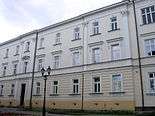 A building of a seminary school in Łomża
A building of a seminary school in Łomża WSA Students group in the front of the main building
WSA Students group in the front of the main building
Sports
The history of sport in Łomża dates back to the end of the 19th century, when the first amateur races were held in 1897. Two years later, Łomża Rowing Society was established, and initiated its activities on January 26, 1902.
The first football club was founded on April 16, 1926, currently known as ŁKS Łomża. There are several sports clubs in town including volleyball, basketball, athletics and martial arts. The most successful Łomżanie would be Athletics, Sports Fighting and Kulturystyce. On June 2009 in Łomża, the Nationwide Finale Gimnazjady football (soccer) for boys was held. The local football team from Public High School No. 8 took third place. Łomża sport is supported by the Society for Promoting Physical Culture and the Łomża School Sports Association. 1998 saw the opening of an indoor sports arena for national and international sporting events, including indoor football matches and Eastern martial arts tournaments.
In 2009, a contract was signed for the construction of a municipal swimming pool to open in 2011, which will be the second such facility in the city. Construction of the swimming pool was co-financed by the EU's regional operational programme for the Voivodship for the years 2007-2013, and its total cost will be 35,200,000 PLN.
- ŁKS Łomża Stadium
 Stadium of ŁKS Łomża football club from Łomża
Stadium of ŁKS Łomża football club from Łomża Łomża Orlik Sports Complex
Łomża Orlik Sports Complex
Economy

The economy of Łomża is closely connected to its natural environment, with agricultural and forestry industries at the forefront of the region's economic development. The economy is ecologically friendly, including the food industries, brewing, electronics, the manufacture of building materials and furniture, the production and processing of agricultural crops, as well as tourism and agro-tourism.
Even the largest companies employ less than 1,000 workers, even though a number of firms are listed on the Podlasie Top One Hundred Entrepreneurs.[11] Among them, the Łomża Brewery (large scale producer of beer), DOMEL (producer of unleaded windows), FARGOTEX (importer of upholstery fabrics), Konrad (importer of farm animals), Łomża furniture factory (Łomżyńska Fabryka Mebli), PEPEES (producer of potato starch), Purzeczko (the personal and property protection). On top of that, the city is a registered office of the Podlasie Agency for Restructuring and Modernisation of Agriculture.
By the end of 2007, the number of people steadily employed in Łomża was 13,408, including 7,170 women,[12] however, the unemployment rate (as of 2009) remained considerably high at 14.1 percent.[13] The number of businesses registered by the end of 2008 was 6,421 of which 6,280 belonged to the private sector.[12]
Points of interest
 Tenement houses on the (Stary Rynek) Old Market Square
Tenement houses on the (Stary Rynek) Old Market Square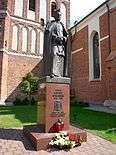 Monument to Cardinal Stefan Wyszyński
Monument to Cardinal Stefan Wyszyński Episcopal Palace
Episcopal Palace Łomża Townhall
Łomża Townhall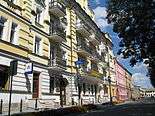 Sienkiewicza street
Sienkiewicza street Jakub Waga Park
Jakub Waga Park Monument to Bielicka
Monument to Bielicka Roundabout of Hanka Bielicka in Łomża
Roundabout of Hanka Bielicka in Łomża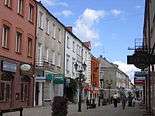 Popular Farna street
Popular Farna street Monument to Pope John Paul II
Monument to Pope John Paul II- The city shell (2006)
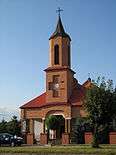 Częstochowska Mother of God Church
Częstochowska Mother of God Church
Notable people
- Julita Fabiszewska, singer/songwriter; participant in Bitwa na głos.
- Yitzhak HaLevi Herzog, Chief Rabbi of Israel and father of Chaim Herzog, 6th President of Israel
- Samuel A. Levine, influential American cardiologist
- Philip L. Rabinowitz, rabbi of Kesher Israel Congregation in Washington, D.C.
See also
References
- ↑ Central Statistical Office (Poland): Population of cities in Podlaskie Voivodeship
- 1 2 3 4 5 6 Qiryat Tiv'on, "Łomża from its beginnings," translated from Hebrew by Stan Goodman, original published by Pinkas haKehilot branch of Yad Vashem
- 1 2 3 Marian Bagiński, Ph.D., "A Different View on the Łomża Region," published by PolishNews.com, 2010
- ↑ Zamoyski, Adam (2008). Warsaw 1920 Lenin's failed conquest of Europe. Harpercollins Pub Limited. ISBN 9780007225521.
- ↑ Chaim Shapiro, "Go, My Son: A Young Jewish Refugee's Story of Survival", New York: Feldheim, 1989.
- ↑ Łomża webpage at www.shtetlinks.jewishgen.org Archived November 1, 2011, at the Wayback Machine.
- ↑ Edelheit, Hershel; Edelheit, Abraham J. (1991). A World in Turmoil An Integrated Chronology of the Holocaust and World War II. Greenwood Publishing Group. p. 216. ISBN 978-0-313-28218-8.
- ↑ "Liczba mieszkańców Łomży, world-gazetteer.com". Archived from the original on 2012-05-15.
- 1 2 3 (Polish) Central Statistical Office, Poland - data of 2007 year Archived September 23, 2012, at the Wayback Machine.
- ↑ (Polish) County Labour Bureau in Łomża: Statistics of the local job market Archived September 21, 2013, at the Wayback Machine.
- ↑ (Polish) "Raport o sytuacji społeczno-gospodarczej miasta Łomża," Urząd Miejski w Łomży, November 2006 (77 pages)
- 1 2 Bank Danych Regionalnych Głównego Urzędu Statystycznego, Łomża
- ↑ Statystyka Lokalnego Rynku Pracy, Powiatowy Urząd Pracy w Łomży Archived September 21, 2013, at the Wayback Machine.
External links
| Wikimedia Commons has media related to Łomża. |
| Wikisource has the text of a 1911 Encyclopædia Britannica article about Łomża. |
- Official website of Łomża City
- Official website of Łomża City for mobile devices
- Łomża City in old documents
- Historical Łomża
- Łomża City in "Geographical Dictionary of Polish Kingdom and other Slavic countries, Vth volume" p. 699-704
- The website about monuments in Łomża
-
 "Lomza". Encyclopedia Americana. 1920.
"Lomza". Encyclopedia Americana. 1920. - Water Tower Sikorskiego street
Coordinates: 53°11′N 22°05′E / 53.183°N 22.083°E




